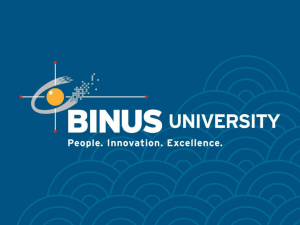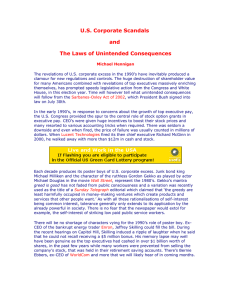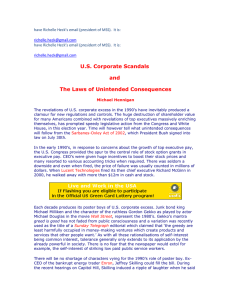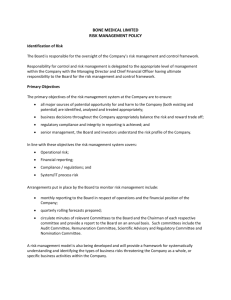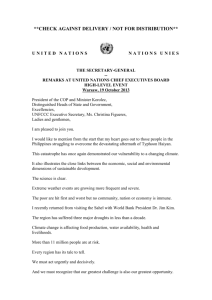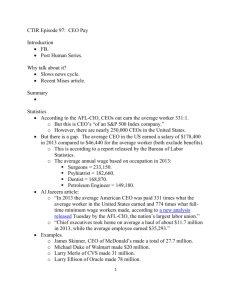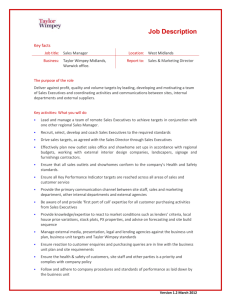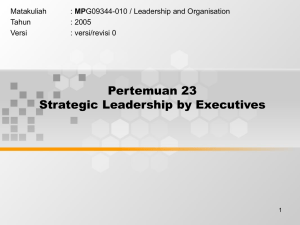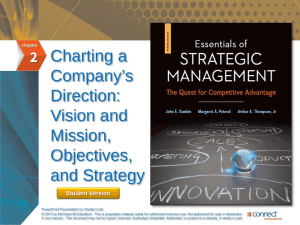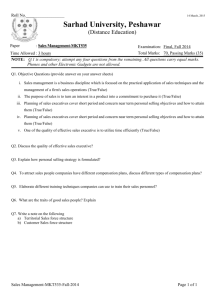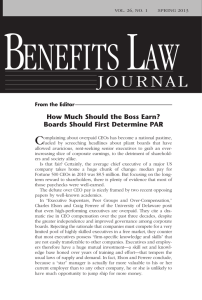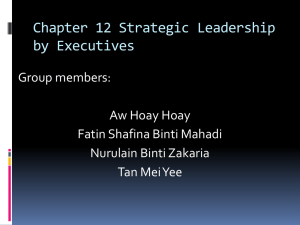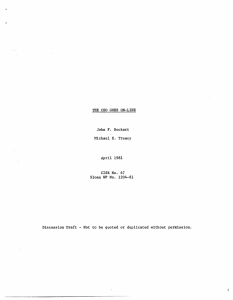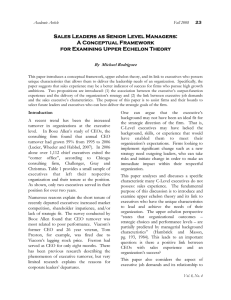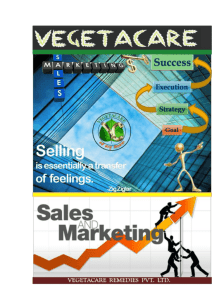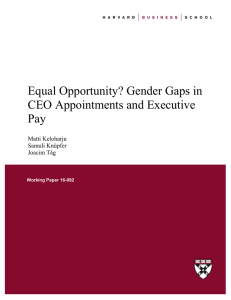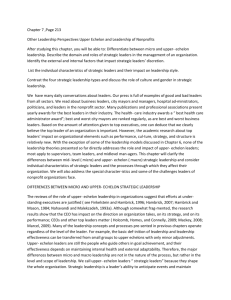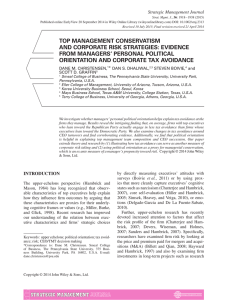the powerpoint presentation
advertisement
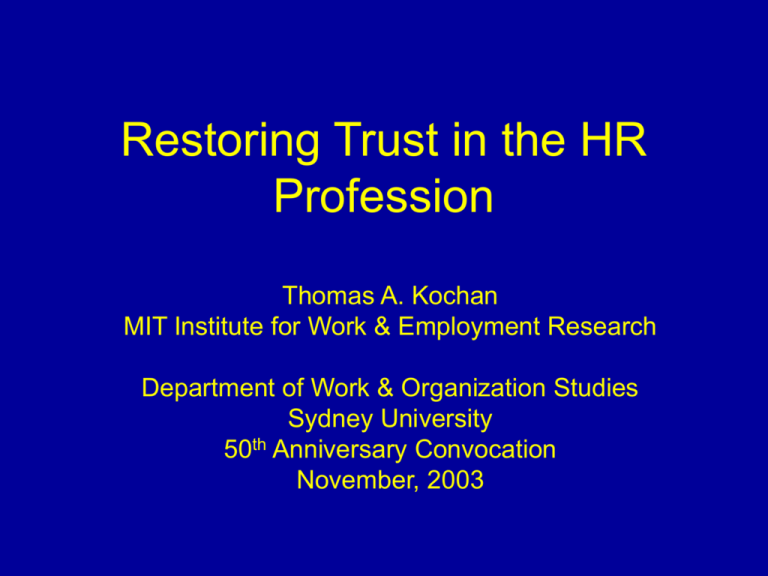
Restoring Trust in the HR Profession Thomas A. Kochan MIT Institute for Work & Employment Research Department of Work & Organization Studies Sydney University 50th Anniversary Convocation November, 2003 The Task Ahead “We have to remember that corporate executives serve at the pleasure and for the interests of shareholders, employees, and their communities, not the other way around…. Managing a company, not a share price, means balancing the requirements of shareowners, customers, employees, and communities…And these relationships of sustainable value require real trust and candor” Source: Carly Fiorina, CEO of Hewlett Packard, October, 2002 HR’s Responsibilities • Restoring Trust in the HR Profession • Building a New Social Contract at Work • Opening the Door to the Next Generation of HR Leaders How we Got Here: Twenty Years of Strategic HRM • From Personnel Administration to HRM • Goal: Become Strategic Partners with Top Executives & Line Managers • Reality: Perfect Agents of Top Executives – HR Executive Survey of Priorities – Ballooning CEO Pay: From 40:1 to 400:1 – An Inward Looking (inside the firm) Profession Today’s Workforce Realities: A Pressure Cooker about to Blow? • Decade of boom & bust leaves working families with: – Stagnant, declining incomes – Increased inequality – Longer working hours – Less retirement savings; fewer health care benefits – Broader job insecurity – Loss of worker voice in society • Current government policies producing: – Further cuts in services & jobs – Tax policies that further increase inequality – Deep divisions over war policies – Direct attacks on workers, unions, and core values Job Satisfaction 56 Co-Workers 64.4 54.9 Interest in Work Pension Plan Health Plan Wages 65 35.7 39.8 35.9 44.2 33.4 39.3 46.8 48.6 Job Security New England United States SOURCE: The Conference Board 43.5 65.4 48.9 58.6 2003 1995 The Seven Top Priorities of HR Executives, 1996 1. 2. 3. 4. 5. 6. 7. Helping their organization reinvent/redesign itself to compete more effectively Reinventing the HR function to be a more customer focused, cost justified organization Attracting and developing the next generation -21st century leaders and executives Contributing to the continuing cost containment/management efforts Continuing to work on becoming a more effective business partner with their line customers Rejecting fads, quick fixes and other HR fads; sticking to the basics that work. Addressing the diversity challenge Source: Human Resource Planning Society Survey, 1996 Meeting the Challenge • Critical Issues & Opportunities – Building Knowledge Based Organizations • Knowledge Workers • Knowledge Based Work Systems – The Dual Agenda: Work & Family Outcomes – Building/Sustaining Productive Labor Management Partnerships • How to Get There – Rebuilding External Alliances – Becoming More Analytical – Rebuilding Trust through Openness & Transparency Managing Knowledge Workers as Assets & Costs • Working with Schools and Universities: – Reversing the Decline in Science, Math, & Engineering Majors – Balancing Technical and Behavioral Skills • Working with other Firms & Unions – Solving the under-investment problem by working together – Engaging the workforce—building general and specific skills – Joint union-management programs: a stable source of funding • Managing Mobile Professionals and Technical Work – Outsourcing and “Off-shoring Debates – Projects with standard employees, contractors, and consultants – Knowledge Worker Networks: Staffing Agencies, professional associations, ethnic enclaves, universities, and firms… “When I recruited MIT students they had great technical grounding but not a good notion of how the real world works, how to get things done, and how to deal with people!” Source: Recently retired CEO Building Knowledge Based Work Systems “In the age of the knowledge-based economy, every citizen must become a new intellectual.” -- Kim Dae Jung, former President of South Korea Productivity/Quality Performance of Selected Auto Assembly Plants Productivity Quality Automation Level (hrs/unit) (defects/100 units) (0 - none) Honda, Ohio Nissan, Tenn. NUMMI, Calif. Toyota, Japan GM, Mich. GM, Mass. 19.2 24.5 19.0 15.6 33.7 34.2 72.0 70.0 69.0 63.0 137.4 116.5 77.0 89.2 62.8 79.6 100.0 7.3 Source: John Krafcik and James Womack, M.I.T. International Motor Vehicle Program, March 1987. The Dual Agenda: Work & Family • Evaluate all HR policies against effects on: – Workplace performance metrics – Personal and family metrics • Increasing use and effectiveness of “Family Friendly” Policies – Focusing on the design of work – Addressing cultural norms • Engaging all the stakeholders – Employees, unions, professional groups, family advocates (maybe even spouses!) – Constructive engagement on public policy issues Focused Labor-Management Partnerships • The critical choice: Union Avoidance or Unionmanagement transformation? – Traditional adversarial labor relations cannot compete with either of the above alternatives – Pace & scope of innovation has been too slow—union declines continue • Lessons from Partnership Examples – Focus on bottom line results not structure & process – Link to critical business and employee needs – Management leadership remains critical—NUMMI, Southwest Airlines as prime examples Restoring Trust through Transparency • Today’s reality: Information thirsty & savvy workforce “Information is power” • The Nike case: “the Nike product has become synonymous with slave labor, forced overtime and arbitrary abuse.” (Phil Knight, CEO) • Negotiating in the age of the internet! • The race is on: HR and the internet savvy youth! The Next Generation HR Leaders Women as a percent of all HR/IR professionals Percent Women HR/IR Managers or Executives 1987 2002 64% 76% 53% 67% A Final Question Will we take up this challenge? Or Pass it on to the next generation of HR leaders? If so, bring on the women!

